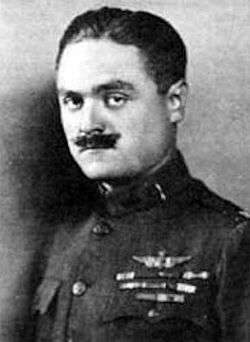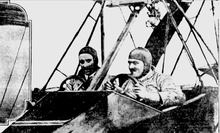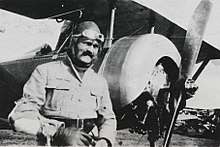William Thaw II
Lieutenant Colonel William Thaw II (12 August 1893 – 22 April 1934) was a World War I flying ace credited with five confirmed and two unconfirmed aerial victories. He is believed to be the first American to engage in aerial combat in the war.[1] He was the first to fly up the East River under all four bridges.[2]
William Thaw II | |
|---|---|
 Lieutenant Colonel William Thaw II, 1918 | |
| Born | 12 August 1893 Pittsburgh, Pennsylvania, |
| Died | 22 April 1934 (aged 40) Pittsburgh, Pennsylvania |
| Buried | Allegheny Cemetery, Pittsburgh, Pennsylvania, Plot: Section: 20, Lot: 55 |
| Allegiance | |
| Service/ | Aéronautique Militaire (France) Air Service, United States Army |
| Years of service | 1914–1918 (France) 1918 (USA) |
| Rank | Lieutenant Colonel |
| Unit | Aéronautique Militaire
Air Service, United States Army
|
| Commands held | 103rd Aero Squadron 3d Pursuit Group |
| Battles/wars | |
| Awards | Distinguished Service Cross with Oak Leaf Cluster, french Legion d'Honneur and Croix de Guerre |


Early life
He was born on August 12, 1893 to Benjamin Thaw, Sr.[1] He learned to fly in 1913, while he was attending Yale University. His father bought him a Curtiss Hydro flying boat that he took to France for the Schneider Trophy races. When war broke out, Thaw gave his airplane to the French and enlisted in the Foreign Legion.[2]
Military career
He joined Escadrille 6.[1] He then became a corporal in Escadrille 42 in 1915, flying a Caudron. He flew a Nieuport in Escadrille 65, before transferring into a French unit composed of American volunteers, known as the Escadrille Americaine, Escadrille 124 under its new designation became nicknamed the Lafayette Escadrille.[2]
Thaw scored his first victory using a Nieuport on 24 May 1916. His next kill was on 27 April 1917. He had two unconfirmed claims in late 1917. He was transferred to the United States Army Air Service, where he commanded the 103rd Aero Squadron and the 3rd Pursuit Group. He would score three quick wins in April and May 1918. His final tally was one enemy observation balloon and four airplanes shot down.[1]
Thaw has been credited with purchasing the Escadrille's famed pet male lion "Whiskey".[3] Purchased by several pilots for 500 francs, the lion was adopted by the unit as a sort of mascot. Eventually Whiskey and a female lion purchased by the Escadrille "Soda" were taken to a Paris Zoo (ref. Air & Space, January 2015), but still remembered the pilot. In one visit, the lions rolled over on their backs in their cage in order to allow Thaw to pet them.[4]
Final years
He married Marjorie Everts on March 2, 1921.[5][6] He died of pneumonia on 22 April 1934 in Pittsburgh, Pennsylvania.[1][5][7] He was buried in Allegheny Cemetery.[1] His widow died in 1936.[6]
Honors and awards
- Distinguished Service Cross (DSC): "The Distinguished Service Cross is presented to William Thaw, Major (Air Service), U.S. Army, for extraordinary heroism in action near Reims, France, March 26, 1918. Major Thaw was the leader of a patrol of three planes which attacked five enemy monoplanes and three battle planes. He and another member of the patrol brought down one enemy plane and the three drove down, out of control, two others, and dispersed the remainder."[1]
- Distinguished Service Cross (DSC) with Oak Leaf Cluster: "The Distinguished Service Cross is presented to William Thaw, Major (Air Service), U.S. Army, for extraordinary heroism in action near Montaigne, France, April 20, 1918. In the region of Montaigne Major Thaw attacked and brought down, burning, an enemy balloon. While returning to his own lines the same day he attacked two enemy monoplanes, one of which he shot down in flames."[1]
- French Ærslegionen.[1]
References
- "William Thaw". Retrieved 2010-10-09.
Abandoning his studies at Yale in 1913, William Thaw, the son of Benjamin Thaw, obtained a pilot's certificate from the Curtiss school and became a flight instructor. When war broke out in Europe, he volunteered for the French Air Service but was rejected. Instead, on 4 September 1914, he joined the French Foreign Legion and served in the trenches. Despite poor vision, defective hearing and a bad knee, Thaw was permitted to join the French Air Service in December 1914. After serving as an observer/gunner, he received flight training and was reassigned to the Escadrille Americaine on 28 April 1916. ...
- Norman Leslie Robert Franks. Nieuport Aces of World War 1. Osprey Publishing. pp. 66–67. ISBN 1-85532-961-1.
- Sengupta, Narayan. "The Lafayette Escadrille" (PDF). p. 57.
- Gibbons, Floyd, Death From Above, Weston County (Upton, WY) Gazette, June 4, 1936, column 3, p. 6
- "Colonel Thaw, War Ace, Dies After Week's Illness ". Pittsburgh Post-Gazette. April 23, 1934. Retrieved 2010-10-09.
Colonel Thaw leaves his widow, Mrs. Marjorie Everts Thaw; a brother, Benjamin Thaw, counsellor of the United States embassy at Oslo, Norway; and a sister, ...
- "Mrs. William Thaw 2D; Widow of the Lafayette Escadrille Commander Dies on Coast". New York Times. March 16, 1936. Retrieved 2010-10-09.
William Thaw 2d of Pittsburgh. At her marriage to Colonel Thaw on March 2, 1921, ... Commander of the Lafayette Escadrille and an "ace" in the World War, ...
- "William Thaw 2nd, War Ace, 40, Dead; Won 3 Citations for Service in Lafayette Escadrille and Third Pursuit Group. Became Aviator in Youth. First to Fly Up East River Under All Four Bridges. Member of Pittsburgh Family". Associated Press in the New York Times. April 23, 1934. Retrieved 2010-10-09.
William Thaw 2d, commander of the heroic little band of American fliers who formed the Lafayette Escadrille and made blazing ...